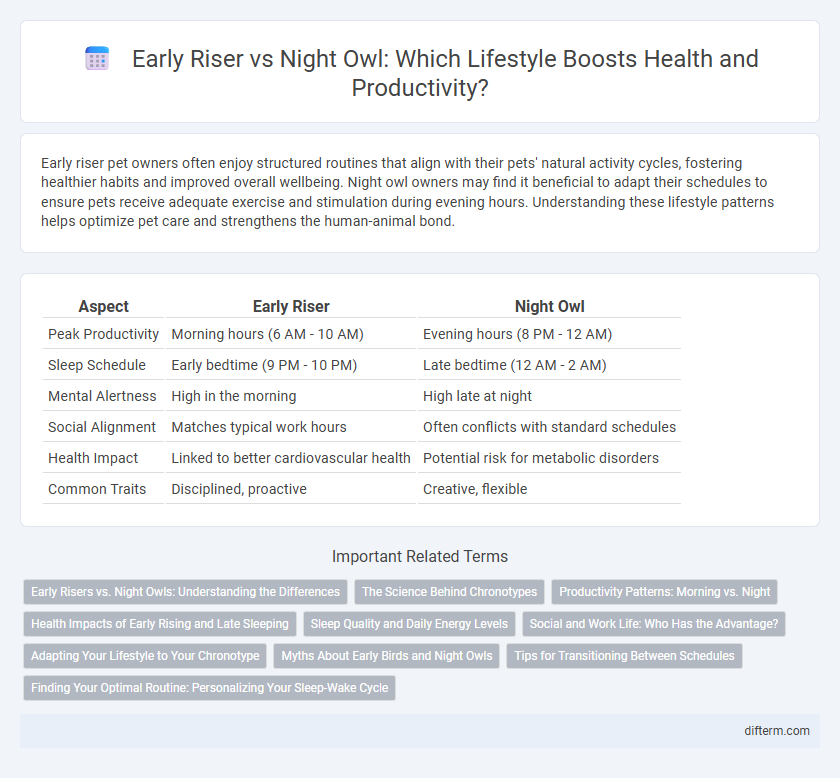Early riser pet owners often enjoy structured routines that align with their pets' natural activity cycles, fostering healthier habits and improved overall wellbeing. Night owl owners may find it beneficial to adapt their schedules to ensure pets receive adequate exercise and stimulation during evening hours. Understanding these lifestyle patterns helps optimize pet care and strengthens the human-animal bond.
Table of Comparison
| Aspect | Early Riser | Night Owl |
|---|---|---|
| Peak Productivity | Morning hours (6 AM - 10 AM) | Evening hours (8 PM - 12 AM) |
| Sleep Schedule | Early bedtime (9 PM - 10 PM) | Late bedtime (12 AM - 2 AM) |
| Mental Alertness | High in the morning | High late at night |
| Social Alignment | Matches typical work hours | Often conflicts with standard schedules |
| Health Impact | Linked to better cardiovascular health | Potential risk for metabolic disorders |
| Common Traits | Disciplined, proactive | Creative, flexible |
Early Risers vs. Night Owls: Understanding the Differences
Early risers tend to experience higher productivity and improved mood during morning hours due to their circadian rhythm alignment with natural daylight. Night owls often demonstrate enhanced creativity and cognitive function during late hours but may face challenges in traditional work schedules. Understanding these chronotypes aids in optimizing daily routines for better health and efficiency.
The Science Behind Chronotypes
Chronotypes are biologically driven patterns that determine individuals' peak alertness and energy levels at different times of the day, primarily influenced by the circadian rhythm regulated by the suprachiasmatic nucleus in the brain. Early risers, or "larks," experience heightened cortisol levels in the morning, optimizing cognitive function and physical performance, while night owls exhibit delayed melatonin secretion, favoring activity and alertness during late hours. Genetic factors such as variations in the PER3 gene contribute to these chronotype differences, impacting sleep-wake cycles, hormonal rhythms, and overall metabolic processes.
Productivity Patterns: Morning vs. Night
Early risers often experience peak productivity in the morning hours, benefiting from increased focus and energy shortly after waking. Night owls tend to reach their highest efficiency late at night, harnessing quieter environments and fewer distractions for deep work. Understanding individual circadian rhythms helps optimize daily schedules for maximal output and well-being.
Health Impacts of Early Rising and Late Sleeping
Early risers often benefit from improved mental health, enhanced cognitive function, and better regulation of circadian rhythms, which contribute to lower risks of cardiovascular diseases and metabolic disorders. Night owls face higher risks of insomnia, depression, and obesity due to misaligned biological clocks and disrupted sleep patterns. Consistent sleep schedules aligned with natural light exposure support optimal hormone regulation and immune system function.
Sleep Quality and Daily Energy Levels
Early risers often experience higher sleep quality due to consistent circadian rhythms, promoting restorative sleep cycles that enhance daily energy levels. Night owls may face disrupted sleep patterns, leading to fragmented rest and reduced alertness throughout the day. Aligning sleep schedules with natural light exposure significantly impacts cognitive function and overall vitality.
Social and Work Life: Who Has the Advantage?
Early risers often benefit from better alignment with traditional work schedules, leading to enhanced productivity and positive social interactions during standard business hours. Night owls may excel in creative tasks and flexible work environments but face challenges with conventional 9-to-5 routines, potentially impacting their social life and professional networking opportunities. Understanding individual chronotypes allows for optimizing work-life balance and leveraging peak energy periods for social and career success.
Adapting Your Lifestyle to Your Chronotype
Adapting your lifestyle to your chronotype enhances productivity and well-being by aligning daily activities with your natural sleep-wake patterns. Early risers benefit from leveraging morning hours for focused work and exercise, while night owls optimize performance by scheduling demanding tasks later in the day. Tailoring meal times, work schedules, and social engagements to fit your chronotype reduces fatigue and improves overall health.
Myths About Early Birds and Night Owls
Common myths suggest early risers are inherently more productive and disciplined than night owls, yet scientific studies reveal that chronotype--whether a person is a morning type or evening type--is largely influenced by genetics and individual circadian rhythms. Productivity and creativity peak at different times for early birds and night owls, debunking the stereotype that one group is superior. Understanding personal biological rhythms allows for optimized work and rest schedules, enhancing overall lifestyle and well-being.
Tips for Transitioning Between Schedules
Gradually adjust your sleep and wake times by shifting them 15-30 minutes earlier or later each day to minimize disruption. Create a consistent pre-sleep routine, such as dimming lights and avoiding screens, to signal your body it's time to rest. Exposure to natural light in the morning helps reset your circadian rhythm, making it easier to adapt to early rising or staying up late.
Finding Your Optimal Routine: Personalizing Your Sleep-Wake Cycle
Discovering your optimal sleep-wake cycle enhances productivity and well-being by aligning daily activities with your natural circadian rhythm. Early risers often benefit from increased morning alertness and structured schedules, while night owls experience heightened creativity and focus during late hours. Tailoring your routine based on chronotype research improves sleep quality, energy levels, and overall lifestyle satisfaction.
early riser vs night owl Infographic

 difterm.com
difterm.com